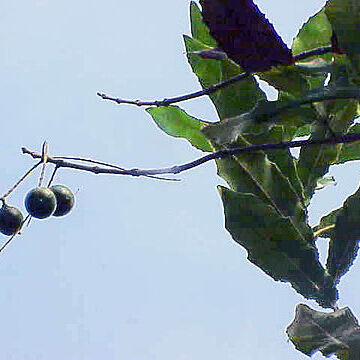Small multi-stemmed tree to 8 m tall. Adult leaves in whorls of 3; petiole 4-10 mm long; lamina narrowly ovate, 9-12.5 cm long, 2-3.5 cm wide, dull above, paler below, rigidly coriaceous, glabrous; base attenuate; margin somewhat undulate, antrorsely spinose; apex acute, mucronate; midrib prominent below, slightly sunken above. Conflorescence simple; rachis 5-18 cm long; bract oblong, 1-5 mm long. Tepals 6-8.5 mm long, pink. Filaments 4-7 mm long, adnate to tepals for 0.5-6 mm. Anthers 1-2 mm long. Ovary 0.4-1 mm long; style 5-10 mm long. Fruit 14-22 mm long, 13-22 mm wide; pericarp c. 1.5-3.5 mm thick. Seeds globose to broadly ovoid, c. 16 mm long, c. 12 mm wide; testa c. 1 mm thick, smooth.
A medium size evergreen tree. It has a bushy habit. It grows 5-10 m tall. The young shoots are pink. Young leaves are long and toothed at the edge. The leaves are 10-18 cm long by 3-5 cm wide. The leaves mostly occur in rings of three. They are stiff, leathery and dark green. Flowers are in stalked clusters 10-20 cm long. They are produced in the axils of leaves and hang downwards. The flowers are 0.8 cm long and pink. The fruit are 1.5-2 cm long and are produced in a hanging cluster. The nuts are smooth, woody, and rounded with a point at the tip.


